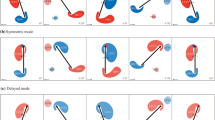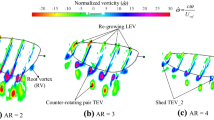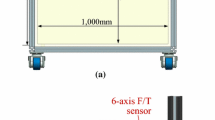Abstract
This paper focuses on flow structures of the wing-wake interaction between the hind wing and the wake of the forewing in hovering flight of a dragonfly since there are arguments whether the wing-wake interaction is useful or not. A mechanical flapping model with two tandem wings is used to study the interaction. In the device, two identical simplified model wings are mounted to the flapping model and they are both scaled up to keep the Reynolds number similar to those of dragonfly in hovering flight since our experiment is conducted in a water tank. The kinetic pattern of dragonfly (Aeschna juncea) is chosen because of its special interesting asymmetry. A multi-slice phase-locked stereo particle image velocimetry (PIV) system is used to record flow structures around the hind wing at the mid downstroke (t/T=0.25) and the mid upstroke (t/T=0.75). To make comparison of the flow field between with and without the influence of the wake, flow structures around a single flapping wing (hind wing without the existence of the forewing) at these two stroke phases are also recorded. A local vortex identification scheme called swirling strength is applied to determine the vortices around the wing and they are visualized with the iso-surface of swirling strength. This paper also presents contour lines of ω z at each spanwise position of the hind wing, the vortex core position of the leading edge vortex (LEV) of hind wing with respect to the upper surface of hind wing, the circulation of the hind wing LEV at each spanwise position and so on. Experimental results show that dimension and strength of the hind wing LEV are impaired at the mid stroke in comparison with the single wing LEV because of the downwash from the forewing. Our results also reveal that a wake vortex from the forewing traverses the upper surface of the hind wing at the mid downstroke and its distance to the upper surface is about 40% of the wing chord length. At the instant, the distance of the hind wing LEV to the upper surface is about 20% of the wing chord length. Thus, there must be a wing-wake interaction mechanism that makes the wake vortex become an additional LEV of the hind wing and it can partly compensate the hind wing for its lift loss caused by the downwash from the forewing.
Similar content being viewed by others
References
Duan H, Zhang Y, Liu S. Multiple UAVs/UGVs heterogeneous coordinated technique based on Receding Horizon Control (RHC) and velocity vector control. Sci China-Tech Sci, 2011, 54(4):869–876
Duan H, Shao S, SU B, et al. New development thoughts on the bioinspired intelligence based control for unmanned combat aerial vehicle. Sci China-Tech Sci, 2010, 53(8):2025–2031
Duan H, Liu S. Unmanned air/ground vehicles heterogeneous cooperative techniques: Current status and prospects. Sci China-Tech Sci, 2010, 53(5):1349–1355
Norberg R A. Hovering flight of the dragonfly Aeschna juncea L. New York: Plenum Press, 1975:763–781
Alexander D E. Unusual phase relationships between the forewings and hindwings in flying dragonflies. J Exp Biol, 1984, 109(1):379–383
Alexander D E. Wind tunnel studies of turns by flying dragonflies. J Exp Biol, 1986, 122:81–98
Azuma A, Azuma S, Watanabe I, et al. Flight mechanics of a dragonfly. J Exp Biol, 1985, 116(1):79–107
Azuma A, Watanabe T. Flight performance of a dragonfly. J Exp Biol, 1988, 137(1):221–252
Wakeling J M, Ellington C P. Dragonfly flight. II. Velocities, accelerations and kinematics of flapping flight. J Exp Biol, 1997, 200(3):557–582
Wang H, Zeng L, Liu H, et al. Measuring wing kinematics, flight tra jectory and body attitude during forward flight and turning maneuvers in dragonflies. J Exp Biol, 2003, 206(4):745–757
Ruppell G. Kinematic analysis of symmetrical flight manoeuvres of odonata. J Exp Biol, 1989, 144(1):13–42
Maybury W J, Lehmann F O. The fluid dynamics of flight control by kinematic phase lag variation between two robotic insect wings. J Exp Biol, 2004, 207(26):4707–4726
Reavis M A, Luttges M W. Aeroodynamic forces produced by a dragonfly. In: AIAA, Aerospace Sciences Meeting, 26th. Reno, NV: AIAA, 1988. 1–13
Saharon D, Luttges M. Three-dimensional flow produced by a pitching-plunging model dragonfly wing. In: AIAA, Aerospace Sciences Meeting, 25th. Reno, NV: AIAA, 1987. 1–17
Saharon D, Luttges M W. Visualization of unsteady separated flow produced by mechanically driven dragonfly wing kinematics model. In: AIAA, Aerospace Sciences Meeting, 26th. Reno, NV: AIAA, 1988. 1–23
Saharon D, Luttges M W. Dragonfly unsteady aerodynamics-The role of the wing phase relations in controlling the produced flows. In: AIAA, Aerospace Sciences Meeting, 27th. Reno, NV: AIAA, 1989. 1–19
Sun M, Lan S L. A computational study of the aerodynamic forces and power requirements of dragonfly (Aeschna juncea) hovering. J Exp Biol, 2004, 207(11):1887–1901
Isogai K, Fujishiro S, Saitoh T, et al. Unsteady three-dimensional viscous flow simulation of a dragonfly hovering. AIAA J, 2004, 42(10):2053–2059
Yamamoto M, Isogai K. Measurement of unsteady fluid dynamic forces for a mechanical dragonfly model. AIAA J, 2005, 43(12):2475–2480
Thomas A L R, Taylor G K, Srygley R B, et al. Dragonfly flight: free-flight and tethered flow visualizations reveal a diverse array of unsteady lift-generating mechanisms, controlled primarily via angle of attack. J Exp Biol, 2004, 207(24):4299–4323
Wang J K, Sun M. A computational study of the aerodynamics and forewing-hindwing interaction of a model dragonfly in forward flight. J Exp Biol, 2005, 208(19):3785–3804
Huang H, Sun M. Dragonfly forewing-hindwing interaction at various flight speeds and wing phasing. AIAA J, 2007, 45(2):508–511
Wang Z J, Russell D. Effect of forewing and hindwing interactions on aerodynamic forces and power in hovering dragonfly flight. Phys Rev Lett, 2007, 99:148101
Usherwood J R, Lehmann F O. Phasing of dragonfly wings can improve aerodynamic efficiency by removing swirl. J R Soc Interface, 2008, 5(28):1303–1307
Lehmann F O. Wing-wake interaction reduces power consumption in insect tandem wings. Exp Fluids, 2009, 46(5):765–775
Dickinson M H, Lehmann F O, Sane S P. Wing rotation and the aerodynamic basis of insect flight. Science, 1999, 284(5422):1954–1960
Birch J M, Dickinson M H. The influence of wing-wake interactions on the production of aerodynamic forces in flapping flight. J Exp Biol, 2003, 206(13):2257–2272
Lu Y, Shen G X, Lai G J. Dual leading-edge vortices on flapping wings. J Exp Biol, 2006, 209(24):5005–5016
Lu Y, Shen G X, Su W H. Flow visualization of dragonfly hovering via an electromechanical model. AIAA J, 2007, 45(3):615–623
Yao D P, Shen G X, Zhu B L, et al. Force measurement of hovering Dragonfly via an electromechanical model. J Exp Fluid Mech, 2011, 25(1):69–75
Lehmann F O. When wings touch wakes: Understanding locomotor force control by wake-wing interference in insect wings. J Exp Biol, 2008, 211(2):224–233
Wang Z J. Dissecting insect flight. Annual Review of Fluid Mechanics, 2005, 37:183–210
Usherwood J R, Ellington C P. The aerodynamics of revolving wings-I. Model hawkmoth wings. J Exp Biol, 2002, 205(11):1547–1564
Usherwood J R, Ellington C P. The aerodynamics of revolving wings -II. Propeller force coefficients from mayfly to quail. J Exp Biol, 2002, 205(11):1565–1576
Wu J H, Sun M. Unsteady aerodynamic forces of a flapping wing. J Exp Biol, 2004, 207(7):1137–1150
Wu Y L, Liu S H, Yuan H J, et al. PIV measurement on internal instantaneous flows of a centrifugal pump. Sci China-Tech Sci, 2011, 54(2):270–276
Huang B, Wang G. Experimental and numerical investigation of unsteady cavitating flows through a 2D hydrofoil. Sci China-Tech Sci, 2011, 54(7):1801–1812
Tian W, Deng X, Wang Y, et al. Study on flow behavior and structure over chined fuselage at high angle of attack. Sci China-Tech Sci, 2010, 53(8):2057–2067
Atif A, Benmansour S, Bois G, et al. Numerical and experimental comparison of the vaned diffuser interaction inside the impeller velocity field of a centrifugal pump. Sci China-Tech Sci, 2011, 54(2):286–294
Lai G, Shen G. Image mapping approach based on biharmonic spline interpolation concerning dot arrangement and multi-mapping. J Beijing Univ Aeronaut Astronaut, 2009, 35(10):1214–1219
Soloff S M, Adrian R J, Liu Z C. Distortion compensation for generalized stereoscopic particle image velocimetry. Meas Sci Technol, 1997, 8(12):1441–1454
Raffel M, Willert C E, Wereley S T, et al. Particle Image Velocimetry. Berlin, Heidelberg, New York: Springer, 2007
Shavit U, Lowe R J, Steinbuck J V. Intensity Capping: A simple method to improve cross-correlation PIV results. Exp Fluids, 2007, 42(2):225–240
Huang C J, Wu Z J, Li Z L, et al. Simultaneous measurement of particle velocity and size based on gray difference and autocorrelation. Sci China-Tech Sci, 2010, 53(10):2833–2838
Lu X, Huang N, Tong D. Wind tunnel experiments on natural snow drift. Sci China-Tech Sci, 2012, 55(4):927–938
Tanimura S, Komiyama M, Takeishi K, et al. Visualization of flashback in a premixed burner with swirling flow. Sci China-Tech Sci, 2010, 53(1):40–45
Yang H, Kim T, Lu T. Characteristics of annular impinging jets with/without swirling flow by short guide vanes. Sci China-Tech Sci, 2011, 54(3):749–757
Hu J, Yang S F, Fu X H. Experimental investigation on propagating characteristics of sinusoidal unsteady flow in open-channel with smooth bed. Sci China-Tech Sci, 2012, 55(7):2028–2038
Zhou J, Adrian R J, Balachandar S, et al. Mechanisms for generating coherent packets of hairpin vortices in channel flow. J Fluid Mech, 1999, 387:353–396
Van Den Berg C, Ellington C P. The three dimensional leading edge vortex of a hovering model hawkmoth. Phil Trans R Soc B, 1997, 352(1351):329–340
Birch J M, Dickinson M H. Spanwise flow and the attachment of the leading-edge vortex on insect wings. Nature, 2001, 412(6848):729–733
Ellington C P, Van Den Berg C, Willmott A P, et al. Leading-edge vortices in insect flight. Nature, 1996, 384(6610):626–626
Willmott A P, Ellington C P, Thomas A L R. Flow visualization and unsteady aerodynamics in the flight of the hawkmoth, Manduca sexta. Phil Trans R Soc B, 1997, 352(1351):303–316
Birch J M, Dickson W B, Dickinson M H. Force production and flow structure of the leading edge vortex on flapping wings at high and low Reynolds numbers. J Exp Biol, 2004, 207(7):1063–1072
Lu Y, Shen G X. Three-dimensional flow structures and evolution of the leading-edge vortices on a flapping wing. J Exp Biol, 2008, 211(8):1221–1230
Huang S. Experimental investigation of fluid mechanics about butterfly hovering fly via an electromechanical model (in Chinese). Dissertation for the Doctoral Degree. Beijing: Beihang University, 2009
Huang S Q, Shen G X, Wei L, et al. Flow visualization of butterfly hovering fly via a mechanical model. J Exp Fluid Mech, 2010, 24(2):59–64
Zhang M M, XU J Z. Active control of fluctuating pressure induced by blade-vortex interaction. Sci China-Tech Sci, 2011, 54(4):862–868
Wang Z J. The role of drag in insect hovering. J Exp Biol, 2004, 207(23):4147–4155
Young J, Walker S M, Bomphrey R J, et al. Details of insect wing design and deformation enhance aerodynamic function and flight efficiency. Science, 2009, 325(5947):1549–1552
Wan Z, Zhang B, Yang C, et al. Static aeroelastic analysis of a high-aspect-ratio wing based on wind-tunnel experimental aerodynamic forces. Sci China-Tech Sci, 2011, 54(10):2716–2722
Song B, Lee C H. A Favré averaged transition prediction model for hypersonic flows. Sci China-Tech Sci, 2010, 53(8):2049–2056
Wu Z G, Chen L, Yang C, et al. Gust response modeling and alleviation scheme design for an elastic aircraft. Sci China-Tech Sci, 2010, 53(11):3110–3118
Gao Z X, Lee C H. A flamelet model for turbulent diffusion combustion in supersonic flow. Sci China-Tech Sci, 2010, 53(12):3379–3388
Meng B, Wu H X. On characteristic modeling of a class of flight vehicles attitude dynamics. Sci China-Tech Sci, 2010, 53(8):2074–2080
Barut A, Das M, Madenci E. Nonlinear deformations of flapping wings on a micro air vehicle. Newport, RI, USA: American Institute of Aeronautics and Astronautics Inc., 2006. 782–806
Pan Z W, Xing Y F, Zhu L W, et al. Liquid propellant analogy technique in dynamic modeling of launch vehicle. Sci China-Tech Sci, 2010, 53(8):2102–2110
Liu H W, Wang Z K, Zhang Y L. Coupled modeling and analysis of radiometer effect and residual gas damping on proof mass in purely gravitational orbit. Sci China-Tech Sci, 2011, 54(4):894–902
Li K B, Chen L, Bai X Z. Differential geometric modeling of guidance problem for interceptors. Sci China-Tech Sci, 2011, 54(9):2283–2295
Wang H B, Qin N, Sun M B, et al. A hybrid LES (Large Eddy Simulation)/assumed sub-grid PDF (Probability Density Function) model for supersonic turbulent combustion. Sci China-Tech Sci, 2011, 54(10):2694–2707
Chen Y, Baoyin H X, Li J F. Trajectory design for the Moon departure libration point mission in full ephemeris model. Sci China-Tech Sci, 2011, 54(11):2924–2934
Yang C, Zhang B, WAN Z, et al. A method for static aeroelastic analysis based on the high-order panel method and modal method. Sci China-Tech Sci, 2011, 54(3):741–748
Xie C, Yang C. Linearization method of nonlinear aeroelastic stability for complete aircraft with high-aspect-ratio wings. Sci China-Tech Sci, 2011, 54(2):403–411
Shyy W, Aono H, Chimakurthi S K, et al. Recent progress in flapping wing aerodynamics and aeroelasticity. Sci China-Tech Sci, 2010, 46(7):284–327
Fan Y, Zhu J, Hu C, et al. Aeroservoelastic model based active control for large civil aircraft. Sci China-Tech Sci, 2010, 53(4):1126–1137
Liu T, Ren Y. Vibration and flutter of wind turbine blade modeled as anisotropic thin-walled closed-section beam. Sci China-Tech Sci, 2011, 54(3):715–722
Yang C, Liu X, Wu Z. Unsteady aerodynamic modeling based on POD-observer method. Sci China-Tech Sci, 2010, 53(8):2032–2037
Chen W Q, Zhu X Y, Huang Z Y. Modeling of multi-inclusion composites with interfacial imperfections: Micromechanical and numerical simulations. Sci China-Tech Sci, 2010, 53(3):720–730
Hamamoto M, Ohta Y, Hara K, et al. Design of flexible wing for flapping flight by fluid-structure interaction analysis. In: 2005 IEEE International Conference on Robotics and Automation (ICRA), Vols 1–4, 2005. 2253–2258. Doi: 10.1109/ROBOT.2005.1570448
Author information
Authors and Affiliations
Corresponding author
Rights and permissions
About this article
Cite this article
Lai, G., Shen, G. Experimental investigation on the wing-wake interaction at the mid stroke in hovering flight of dragonfly. Sci. China Phys. Mech. Astron. 55, 2167–2178 (2012). https://doi.org/10.1007/s11433-012-4907-2
Received:
Accepted:
Published:
Issue Date:
DOI: https://doi.org/10.1007/s11433-012-4907-2




